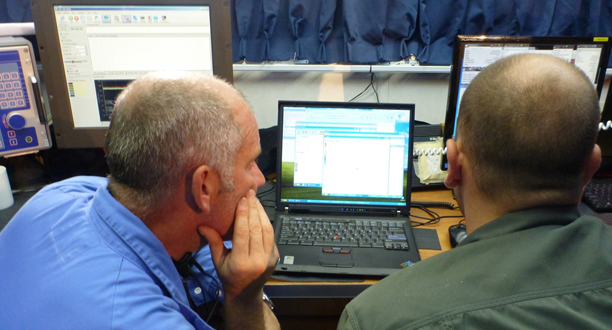We’ve Got a Deep-Diving Sub

Jacquinot Bay, New Britain Island, Papua New Guinea
Today Jim Cameron did all the things he’s been dreaming about since he began the engineering development of the DEEPSEA CHALLENGER eight years ago.
At 3:30 this afternoon, Jim was in the pilot sphere of the DEEPSEA CHALLENGER when it was lowered into the ocean, the dense-jungle mountains of New Britain Island in the background.
Two small inflatable boats moved in and four divers slipped into the water to release the sub’s tag lines and take photographs of her downward departure. Thirty minutes later, Jim told the surface control team he was ready for descent. Then he said the words that signal the divers to unhook the last two lift bags: “Release. Release. Release.”
A short time later, Tim Bulman tried to contact Jim from the ship’s communication room. “DEEPSEA CHALLENGER. DEEPSEA CHALLENGER. This is Mermaid Sapphire. Do you read?” There was no response. Bulman tried again, and for 16 long minutes there was no answer. Then came the words we’d been waiting to hear: “Copy you surface control. Read you loud and clear.”
Twenty-two minutes after leaving the surface, Jim was almost halfway to the bottom and falling smoothly. As he descended through the darkness, the sub’s PAC control system sent up data at three-minute intervals about the conditions inside the crew sphere. On the ship’s bridge we saw the crew sphere’s temperature, depth, battery status, oxygen and carbon dioxide levels. Thirty minutes later Jim slowed his descent and landed on a flat, featureless seafloor at a depth of 3,250 feet (991 meters). Momentarily, a thick cloud of disturbed sediment enveloped the sub.
For the next five hours, Jim tested all the sub’s systems, from electronics to hydraulics to cameras. He explored the seafloor and took video images of crinoids and a magnificent, free-swimming holothurian for review by on-board scientists. He flew the sub at three knots above the sediments, found the lander Mike, named for Mike deGruy, and took video images of the ten-foot (three-meter) device standing proud on the bottom.
Subtle choreography between the men on the ship and the man inside the sphere allowed a blaze-of-light, seafloor rendezvous with the ship’s big yellow ROV. As the two machines took pictures of each other, Jim and the ROV operator, Donny Cameron, a big, blond man from Scotland, exchanged excited words and laughter. At one point Donny said to Jim, “How cool is this? Two Camerons from opposite sides of the Atlantic meet 2,900 feet under the South Pacific.”
Just before 10 p.m., Jim used his vertical thrusters to position the sub a few feet off the bottom, flipped a switch, released the ascent weights and rose like a rocket. It took him just seven minutes to travel the more than half-mile to the surface. “I’ve never seen a machine move so fast in the ocean,” said Captain Buckle, who tracked the ascent on a screen on the bridge.
As he rose toward the surface, Jim turned on the sub’s spotlight and saw dusty flakes and small brown slabs streaming down the sides of the sub. “It looked like the stuff that comes off a rocket just after liftoff,” he said, “It was a smoke trail—made by the sediment that boiled up into the shroud when I landed.”
As soon as he came out of the sub, Jim said words that he would repeat many times during the next hours: “Thanks to all of you, that was a triumph. We’ve got a lot of things to improve, but we’ve got a deep-diving sub.”
Photograph by Larry Herbst



